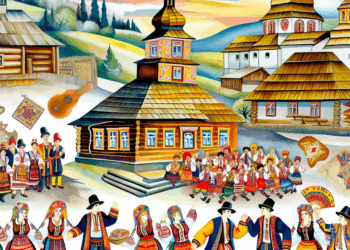Introduction
Bukovyna, a region nowadays divided between Ukraine and Romania, has been a crossroads of cultures and civilisations for centuries. Its history is full of interesting events and significant personalities who left their mark in the cultural and social context. In this article we propose to familiarise ourselves with little-known but important data about Bukovyna in different historical periods.
Princely times
The first information about Bukovina dates back to the IX-X centuries, when this territory was a part of Kievan Rus’. It is noteworthy that the first written record about Bukovina was made in the “Tale of Igor’s Regiment”, which dates back to the end of XII century. This territory was inhabited by Slavs and later came under the influence of Poland and Moldavia.
Moldavian princes
In the fourteenth and fifteenth centuries, Bukovina was ruled by the Principality of Moldavia. Princes such as Stephen III the Great actively developed the region, emphasising the strengthening of borders and the development of trade. Interesting point: Bukovina became an important trade route due to its strategic geographical location.
Stephen III, who ruled from 1457 to 1504, is known not only for his successful fight against the Ottomans, but also for creating a system of defences. What is less well known, however, is the fact that it was during these times that cultural and religious construction developed. The churches and monasteries built, such as St. John’s Monastery in Chernivtsi (founded in 1487), became centres of enlightenment.
Times of the Austrian Empire
From 1775, after the Peace of Rakoszej, Bukovina became part of the Austrian Empire. This period was a time of significant economic and cultural changes.
Administrative reforms
The Austrian administration introduced a number of reforms aimed at modernising the region. In 1786, the University of Chernovtsy was founded, which became the first university in Bukovina. It is hard to overestimate its importance: the university became a cultural centre where famous personalities such as the writer and philosopher Dmytro Doroshenko and the composer Ion Sperna studied. The study of German and Romanian languages became an important area of study, which facilitated cultural exchange.
Cultural diversity
During this period Bukovina became a kind of “cultural cocktail”. Different nationalities coexisted here, including Ukrainians, Romanians, Germans and Jews. It is a little known fact that at the end of the 19th century, the first Jewish women’s gymnasium in Eastern Europe was founded in Chernivtsi.
Among the significant personalities of this time we can highlight Eugene Shvartsman, a prominent Shevchenko and cultural figure who promoted Jewish culture in the region.
Interwar years
After the First World War, Bukovina was ceded to Romania. This period was a time of both political change and cultural flourishing.
Political changes
In 1918, after the collapse of the Austrian Empire, the Romanian authorities introduced several reforms that dealt with land relations and administrative division. A little-known fact is that in 1927 a new system of class taxation was introduced, which led to notable social changes.
Cultural development
The interwar years in Bukovina can be considered a time of cultural turbulence. In 1920, the Association “Bukovina” was founded, which united various cultural and scientific societies. One of the active participants was the writer and public figure Arkady Kostenko, who contributed to the popularisation of Ukrainian literature. Theatre art was also developing during this period; the Ukrainian Academic Theatre was opened in Chernivtsi, which became an important centre of Ukrainian culture in the region.
Soviet era
After World War II, Bukovyna was once again under the rule of the Soviet Union. This period brought with it both limitations and new opportunities.
Collectivisation
In the 1940s, collectivisation began in the region, which significantly changed agriculture. A little-known fact is that in 1948 the first collective farm movement in the region was formed, which became a model for the subsequent mass development of collective farms. Many peasants, having spent their labour under collective farm conditions, felt the transformation not only in the economic sphere, but also in social relations.
Cultural life
Despite the policy of censorship, the region managed to preserve some cultural traditions. In 1952, a professional theatre was established in Chernivtsi, which continued to work under difficult conditions. Another significant event was the organisation of the first Bukovyna artists’ exhibition in 1958, which showcased the works of local masters.
Among the brightest personalities of this time is the poet Dmytro Pavlichko, who contributed to the restoration of the Ukrainian writing tradition with his work.
Conclusion
The history of Bukovyna is full of significant events and personalities that shaped the culture and social life of this region. From the princely times to the Soviet period, each era left its mark, creating a unique cultural and historical context. Studying these little-known facts helps us to better understand the significance of Bukovyna in the context of the general history of Ukraine and Eastern Europe.
The region, often forgotten in broader narratives, deserves attention and recognition for its cultural diversity and rich history. The history of Bukovyna is a story about people, cultural exchange and the constant search for identity in a changing world.








